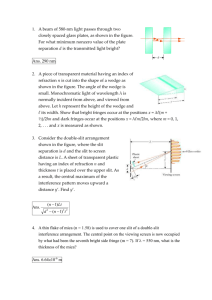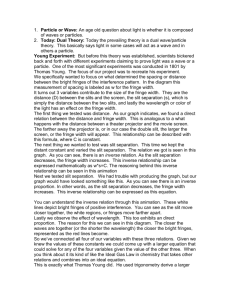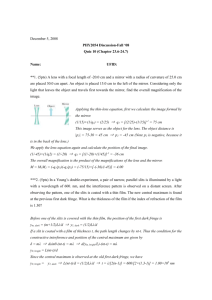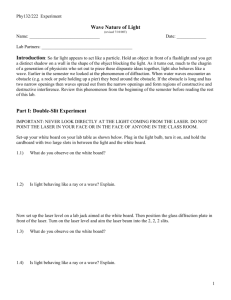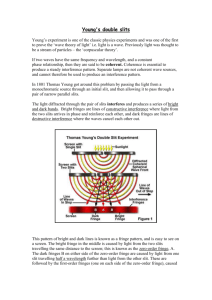Calculations Table 1: Single Slit
advertisement
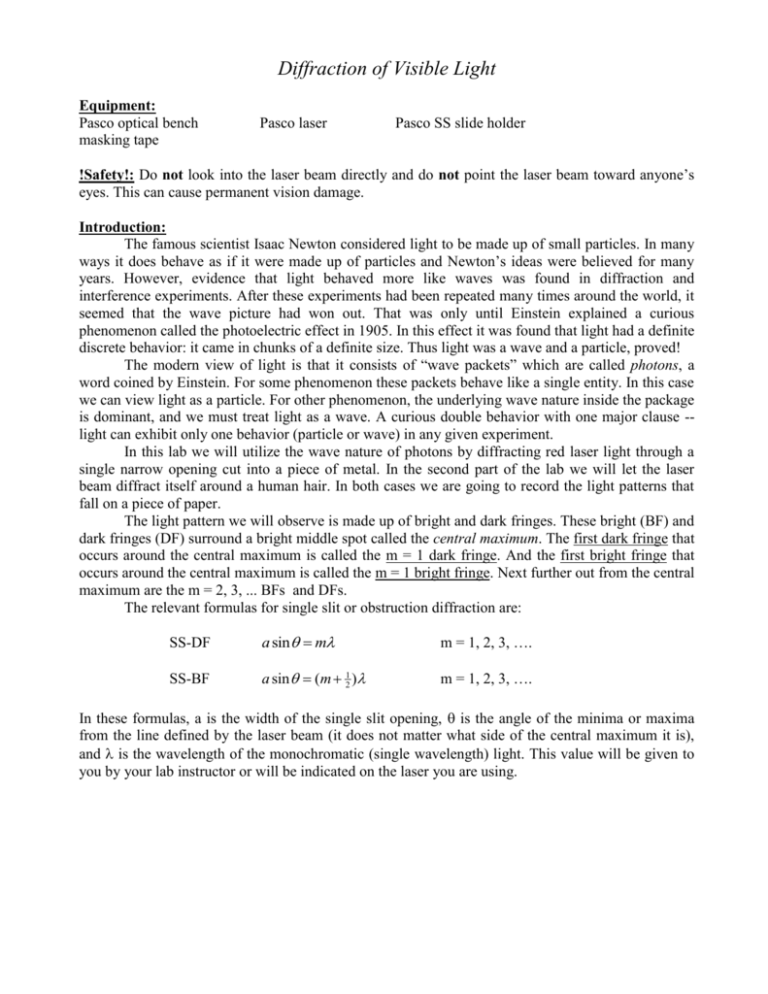
Diffraction of Visible Light Equipment: Pasco optical bench masking tape Pasco laser Pasco SS slide holder !Safety!: Do not look into the laser beam directly and do not point the laser beam toward anyone’s eyes. This can cause permanent vision damage. Introduction: The famous scientist Isaac Newton considered light to be made up of small particles. In many ways it does behave as if it were made up of particles and Newton’s ideas were believed for many years. However, evidence that light behaved more like waves was found in diffraction and interference experiments. After these experiments had been repeated many times around the world, it seemed that the wave picture had won out. That was only until Einstein explained a curious phenomenon called the photoelectric effect in 1905. In this effect it was found that light had a definite discrete behavior: it came in chunks of a definite size. Thus light was a wave and a particle, proved! The modern view of light is that it consists of “wave packets” which are called photons, a word coined by Einstein. For some phenomenon these packets behave like a single entity. In this case we can view light as a particle. For other phenomenon, the underlying wave nature inside the package is dominant, and we must treat light as a wave. A curious double behavior with one major clause -light can exhibit only one behavior (particle or wave) in any given experiment. In this lab we will utilize the wave nature of photons by diffracting red laser light through a single narrow opening cut into a piece of metal. In the second part of the lab we will let the laser beam diffract itself around a human hair. In both cases we are going to record the light patterns that fall on a piece of paper. The light pattern we will observe is made up of bright and dark fringes. These bright (BF) and dark fringes (DF) surround a bright middle spot called the central maximum. The first dark fringe that occurs around the central maximum is called the m = 1 dark fringe. And the first bright fringe that occurs around the central maximum is called the m = 1 bright fringe. Next further out from the central maximum are the m = 2, 3, ... BFs and DFs. The relevant formulas for single slit or obstruction diffraction are: SS-DF a sin m m = 1, 2, 3, …. SS-BF a sin (m 21 ) m = 1, 2, 3, …. In these formulas, a is the width of the single slit opening, is the angle of the minima or maxima from the line defined by the laser beam (it does not matter what side of the central maximum it is), and is the wavelength of the monochromatic (single wavelength) light. This value will be given to you by your lab instructor or will be indicated on the laser you are using. x(fringe) slit laser L = slit to screen distance Procedure for Slit Screen: Measure and record the distance from the slit to the screen. A piece of paper taped to a vertical surface will suffice. One meter is a convenient distance Laser/Slit: Arrange the laser and diffraction slit so that the beam passes through the center of the slit. Central Maximum: Mark the CM with a long vertical line. DFs: (|) Mark the DFs with short vertical lines. BFs: (-) Mark the BFs with short horizontal lines. Procedure for Hair Replace the slit with a hair taped across the holder. Note any change in L if it occurs. Determine the DFs and BFs produced by the laser light passing over the hair. Questions 1. Characterize the accuracy and precision of your dark and bright fringe data for the slit. Assume the given value for the slit is true. Explain any large discrepancies. 2. Characterize the precision of your dark and bright fringe data for the human hair. Do you believe your result? If so, why? If not, why not? Data Table 1: Single Slit Width of slit marked on slide __________________ Measured slit to screen distance L = ____________ Wavelength of Laser Light ___________________ fringe order, “m” 1 distance to dark fringes (x) distance to bright fringe (x) Calculations Table 1: Single Slit fringe order (“m”) 1 L (m) dark: a x L (m 1 ) bright: a 2 x 2 3 4 5 6 2 3 4 5 6 Average value of width for dark fringes +/- standard error ____________________ Average value of width for bright fringes +/- standard error ___________________ Data Table 2: Human Hair Distance L = ____________ fringe order, “m” 1 distance to dark fringes (x) distance to bright fringe (x) 2 Calculations Table 2: Human Hair fringe order (“m”) 1 2 L (m) dark: a x L (m 1 ) bright: a 2 x 3 4 5 6 3 4 5 6 Average value of width for dark fringes +/- standard error ____________________ Average value of width for bright fringes +/- standard error ___________________


